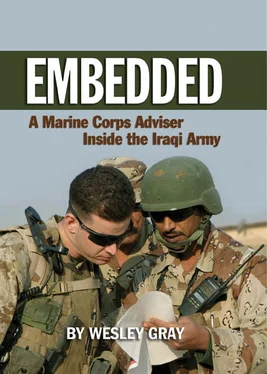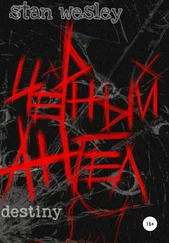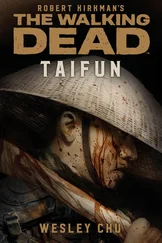After training we left Camp Taji and arrived at Camp Fallujah. I was glad we were back in Marine country and had left the grips of the U.S. Army’s culture of bureaucracy and back rubs for everyone. The main event in Fallujah was to attend the IED training site.
When it comes to training, the Marine Corps has mastered the process. The IED training site at Camp Fallujah was a perfect excellent example of doing things right. The training site covered three acres on the outskirts of camp and was set up to represent as many real-life IED situations as possible in a small space. The one aspect of the training site that stood out was its realism. The EOD (explosive ordnance disposal) Marine in charge of the training brought actual IED material he had found in live scenarios and placed it on the training site in the exact scenario in which he had found it.
Staff Sergeant Wilkenson, our motivated instructor and an outstanding Marine, led our team through the course. Wilkenson was a poster boy Marine—a chiseled jaw, strong build, and the ability to slay dragons—but what really stood out about him was his positive attitude. He had been the victim of IED attacks many times, and a majority of his EOD teammates had been killed during his deployment. And yet he was upbeat and ready to train.
At the beginning of the IED course Wilkenson announced, “Marines, I want you to get prepared for the most fucked up Easter egg hunt in the world.” This was a great analogy. Even so, we walked through the course in the 130-degree heat without a complaint. Everyone on the team was so concerned with finding the IEDs and learning the enemy’s tactics that we forgot about the heat.
Throughout the course an eerie theme played out multiple times. First, the springbutts (Marine Corps term for someone who is always answering the instructor’s questions) on the team, Captain McShane and Staff Sergeant Donaldson, would inevitably stop and gaze at what looked like an IED in the side of the road a hundred meters ahead of us. Wilkenson would sarcastically reply, “Wow, great eyes gentlemen. Now, how about you look below your feet… the insurgents left a surprise for you.” As we would look to the earth, Wilkenson would explain how the IED up ahead was a decoy to get unsuspecting victims to stop in their tracks right on top of a live IED. Sure enough, we would be standing on a couple of double-stacked propane tanks filled with five hundred pounds of PE-4 high-explosive material that had been buried beneath our feet (PE-4 is a cheap Russian knock-off of what American service members know as C-4). Fortunately, we were in training.
After reaching our certain death at least five times over the next five hundred meters of the IED course, we were able to recognize an IED before it “exploded.” Donaldson picked up the radio-controlled IED ignition device off the ground to see how the device functioned.
Wilkenson lunged at Donaldson and yelled, “Boom! Congratulations, you all became chop suey and made the same mistake my EOD robot made the other week. He is now chilling in the scrap yard with R2-D2 and C-3PO.” Donaldson protested. “What are you talking about?” he said. “We found the IED. How did we die?” Wilkenson retorted, “Well, you’re right, you guys did find the IED; however, that didn’t blow you up. Look under the ignition device you just picked up.” We all peered underneath the ignition device, which was a Sanyo cordless telephone base station. Sure enough the base station had been rigged with some electric tape and a short piece of copper wire that led to a 155-mm artillery shell buried beneath the base station. The artillery shell was waiting to blow up whoever got curious and decided to pick up the ignition device. Whoops.
At the conclusion of the course Wilkenson told us his favorite IED story. Some time ago he had taken a cell phone from a discovered IED site that was attached to the ignition device on an IED. By some wicked twist of fate, when his EOD team was traveling back to base, it started ringing. Wondering what the hell was going on, he answered the phone call. It was the insurgents. Wilkenson said that he and the insurgents cursed each other out and told each other to rot in hell, Wilkenson in broken Arabic and the insurgents in broken English. I am sure Wilkenson wished he could have somehow traveled through the phone, showed up on the other end, and opened a Costco-sized can of whup-ass on the insurgents.
Lieutenant Adams summed up the team’s collective thoughts at the conclusion of the course: “Damn, this is gonna suck.” We left the training site with little confidence and a high awareness of our mortality. Tomorrow we would arrive in Haditha. Let the adventure begin.
Chapter 4
Meeting the Iraqi Army
August 2006
Flying a few hundred meters above the ground aboard a CH-53 Super Stallion helicopter, I could see the villages’ lights flickering off the Euphrates River, spinning off beautiful blue and purple colors. An eerie darkness engulfed each settlement, as if these villages were little islands in the middle of the Pacific Ocean.
Swack! Maj. Travis Gaines hollered, “Whoa, shit! What’s going on?” I snapped out of my dreamy gaze on the landscape, wondering what had happened. Were we crashing? Had the pilot fallen asleep and run into something? We were still a good 150 meters in the air. The commotion felt as though we were landing the bird, but this was impossible at this height.
In Iraq, I discovered, anything is possible. It turned out we were landing, and we were 150 meters off the ground. The commotion was the helicopter landing on top of the Haditha Dam. Surprised that we seemed to be landing in midair at 0330 in the morning, each of us clutched our three hundred pounds of gear and waddled like penguins out the back of the bird. Members of the outgoing MiTT rushed to our aid with energy and excitement. Each of them grabbed at our gear like hungry hyenas, helping in every way they could.
But I was suspicious. Our hosts’ generosity was in doubt. My suspicions were born out by SSgt. John Wear, who said, “Gentlemen, you don’t know how excited we are to see you. We cannot wait for you to take over for us so we can get the hell out of here. Oorah!”
Once the chaos of the CH-53 engines and rotors subsided, I took a deep breath. I had arrived. From this day forward we would be making history. Here I was standing atop the famous Haditha Dam, the second largest electricity production plant in all of Iraq. To my north was beautiful Lake Qadisiyah and to the south were the magnificent Euphrates River and the civilizations that make up the Triad: South Dam Village, Barwana, Haditha, Haqliniya, Bani Dahir, and Abu Hyatt.
Once the trucks were loaded we made our way to the Iraqi camp. I fell asleep in the truck and awoke to see an armed Marine opening a steel gate. With a sarcastic tone in his voice he said, “You must be the new guys… that sucks. Enjoy the Iraqi side of the camp.” As we entered the camp I realized we were leaving the relative safety of six hundred U.S. Marines and were now entering the Wild West. Here our neighbors would be a small group of U.S. Army Special Forces and three hundred IA soldiers.
We entered the MiTT camp, which was a small, square area about the size of a baseball diamond (see photo 2). Bulletproof Hesco barriers barricaded the camp on all sides (Hesco barriers are seven-foot-tall and six-foot-wide containers wrapped in a wire mesh that is filled with dirt and sand). Upon our arrival the boss said, “It’s 0445 now. Drop your gear in your rooms and be ready for action tomorrow morning by 0830.” He paused before continuing. “Tomorrow we will observe the Iraqi mission planning briefs and conduct a liaison meeting with the 3rd Battalion, 3rd Marines (3/3) battalion commander in the dam. Go to your rooms and have a nice night.”
Читать дальше












